Huawei P50 review — a smartphone with an optimal price-performance ratio
Miscellaneous / / August 22, 2022
An interesting option in the world of ever-rising gadgets.
In February, a flagship appeared in Russia Huawei P50 Pro with their strengths and weaknesses. Now we got our hands on the base model of this series - P50. It's slightly simpler in features and more affordable, but with the same design and a great camera, which makes it perhaps even more interesting. Why this smartphone deserves your attention, we will tell in the review.
Table of contents
- Specifications
- Design and ergonomics
- Screen
- Biometrics
- Performance
- System
- cameras
- Autonomy and charging
- Results
Specifications
| Operating system | EMUI 12 (based on Android without Google services) |
| Frame | Aluminum + glass, waterproof IP68 |
| Screen | OLED, 6.5", 2700 × 1224 pixels, 90Hz, DCI‑P3 coverage |
| CPU | Qualcomm Snapdragon 888 (5nm) |
| Memory | 8 GB - operational, 256 GB - built-in (+ nanoSD up to 256 GB) |
| cameras | Main: main - 50 MP, f / 1.8 with PDAF, Laser AF and OIS; ultra wide-angle - 13 MP, f / 2.2; telephoto module - 12 MP, f / 3.4 PDAF, OIS, optical zoom × 5. Front: 13 MP, f/2.4. |
| Communications | 2G, 3G, LTE, Wi‑Fi 6, Bluetooth 5.2, NFC |
| Navigation | GPS (L1 + L5), A‑GPS, GLONASS, BeiDou, GALILEO (E1 + E5a), QZSS (L1 + L5), NavIC |
| Battery | 4 100 mAh; Charging – 66W (wired) |
| Connectors | USB Type-C 3.1 |
| Dimensions | 156.5×73.8×7.9mm |
| The weight | 181 g |
| Additionally | Optical fingerprint scanner, stereo speakers |
Design and ergonomics
For several years now, Pro versions of Huawei flagships have been getting displays with curved edges. Not everyone likes such "waterfalls", so there is always a model with a regular flat screen in the line - just like the P50.
The profile of the front panel always corresponds to the back cover. In this case, it has a slightly streamlined edge, but lacks pronounced curves on the sides, like the P50 Pro. As a result, the smartphone has become less slippery.
The frame of the case is metal, chrome-plated, a slightly muted shade - in combination with a black glass back panel, it looks great. True, the back is traditionally easily soiled, so all the beauty will have to be hidden in a silicone case, which is included in the standard kit.
The same accessory will protect the photomodule of the smartphone from accidental damage, which has the same appearance as the P50 Pro: with two protruding circles. However, the set of modules for gadgets is slightly different, but more on that later.
At the top of the smartphone are two microphones and speaker holes. Bottom - USB-C port, another microphone, a second speaker and a tray for SIM card and nanoSD memory. The latter has a seal that prevents water from getting inside - a necessary part to confirm the moisture protection class IP68It is allowed to dive to a depth of more than 1 m for a duration of not more than 30 minutes.. The main thing when removing the tray is not to insert a paper clip into the microphone (it is on the right, closer to USB‑C).
The power and volume buttons are located on the right side, with the first one below. This is much more convenient, unless you are used to a different location, such as on Pixel 6. The keys themselves are pressed gently, but tangibly, with a slight click.
In everyday use, the smartphone turned out to be convenient, including without a case. The case is perfectly assembled and feels very solid and reliable. However, do not forget that there is glass in front and behind, and of unknown origin (Huawei does not name the manufacturer), so it is better not to test it once again for strength.
Screen
The smartphone has a flat screen, rounded corners and minimal frames – there is practically no “chin”. The film is pasted right out of the box.
Diagonal - 6.5 inches. The resolution is 2700 × 1224 pixels. As in the case of the Pro version, there is a high-quality OLED matrix, but the picture refresh rate is 90 Hz instead of 120 Hz.
It also claims a touch layer frequency of 300 Hz and a PWM dimming of 1,440 Hz. Simply put, the screen responds very quickly to pressing and does not flicker at all even at minimum brightness. And indeed it is.
The display supports DCI‑P3 color gamut (more than a billion shades) - the picture is very saturated and contrasting, but not hitting the eyes. If it does not seem juicy enough, you can select the “Vivid” color mode in the settings, but for me this is already too much. Even in normal mode, the P50 display visually outperforms the same Pixel 6, which is equipped with an OLED panel with similar characteristics. In general, for the screen just like.
Biometrics
Without straying too far from the topic of the display, a fingerprint scanner is integrated into the bottom of the panel - very fast and accurate. Works flawlessly in any position of the smartphone - you can bring your finger up, down or sideways. The only thing you can find fault with is the size of the reading area: I would like it to be a little larger.
And immediately I note that an alternative way to unlock the screen is to recognize the user in the face. Yes, this technology is implemented on the basis of only one front camera and does not build a three-dimensional model, but it works like a clock. With glasses, in a baseball cap, at arm's length, at night (screen glow is enough) - no problem. The smartphone will always recognize you and instantly unlock.
Performance
The processor and memory here are exactly the same as in the Pro version: the already old Snapdragon 888 with an LTE modem, 8 GB of RAM and a 256 GB drive. The chip also heats up, as in all other smartphones, although it feels not as critical in the P50 as in the older model.
The situation is similar with throttling. According to CPU Throttling, the P50 starts dropping performance levels earlier, but it doesn't do it as drastically as the Pro version. However, there is no need to talk about stability.
In the AnTuTu benchmark, which assesses the overall performance of the device, the P50 scored 574,418 points and lost to the P50 Pro with 623,000. And if you believe the test, then the GPU accelerator received a lower score, although the graphics of the models are the same - Adreno 660.
Numbers strange, but I don’t want to draw attention here at all: the real performance here is flagship, despite the far from the newest chip. The smartphone works quickly and smoothly, copes with games perfectly. With regard to system processes, animations and application launches, there are no slowdowns and hints of them. This is the main thing.
System
The smartphone runs on EMUI 12 - it's still Android, albeit devoid of Google services. How to install them, what programs are available and what is interesting about the shell itself, you can read in the review Huawei P50 Pro. Everything here is absolutely identical.
In short, EMUI is quite convenient, with a lot of useful gadgets, but without fresh ideas in visual design. It almost does not change externally, but is actively developing in terms of content - this applies to both new features and the pre-installed AppGallery application store, which continues to grow.
By the way, it also has applications for contactless payment with a smartphone - Mir Pay and "SBPey». Plus, Huawei Pay is already preinstalled on the device. It is available through the Huawei Wallet application, but so far it only works with four banks: Gazprombank, Rosselkhozbank, Vostochny, Solidarity.
cameras
The P50's main camera is the same as the P50 Pro's, with the marketing name True‑Chroma. Here, the resolution is 50 megapixels, f / 1.8 aperture, optical image stabilization, as well as laser and phase focusing. During the day and indoors with good light, cool shots are obtained.

1 / 0
Photo: Victor Podvolotsky / Lifehacker

2 / 0
Photo: Victor Podvolotsky / Lifehacker
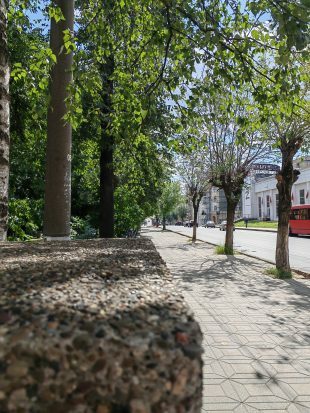
3 / 0
Photo: Victor Podvolotsky / Lifehacker

4 / 0
Photo: Victor Podvolotsky / Lifehacker
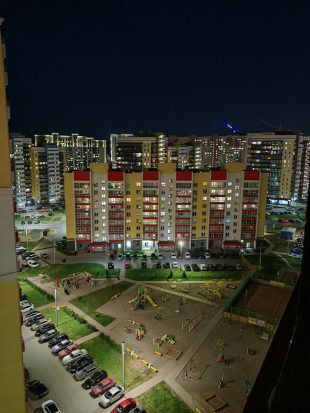
5 / 0
Photo: Victor Podvolotsky / Lifehacker

6 / 0
Photo: Victor Podvolotsky / Lifehacker
In theory, the P50 should be slightly inferior to the Pro version, since it does not have an auxiliary monochrome sensor, but in practice you can see the difference between them, probably, only with a direct comparison pictures. In general, in everyday use, the camera pleased both during the day and at night.
The only niggle is still with HDR, which in automatic mode does not always work when it is needed.
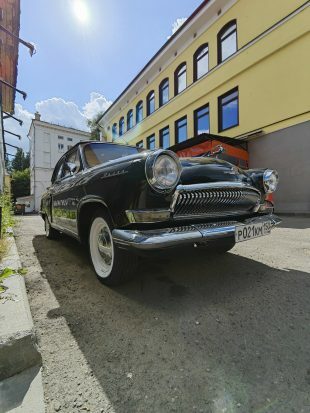
1 / 0
Photo: Victor Podvolotsky / Lifehacker
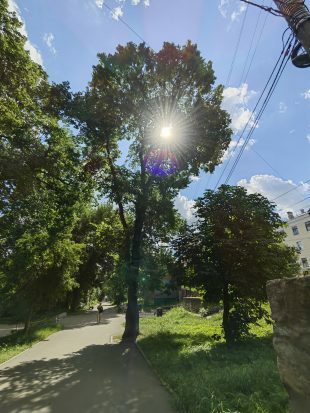
2 / 0
Photo: Victor Podvolotsky / Lifehacker

3 / 0
Photo: Victor Podvolotsky / Lifehacker
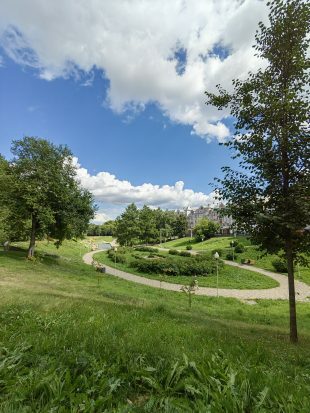
4 / 0
Photo: Victor Podvolotsky / Lifehacker
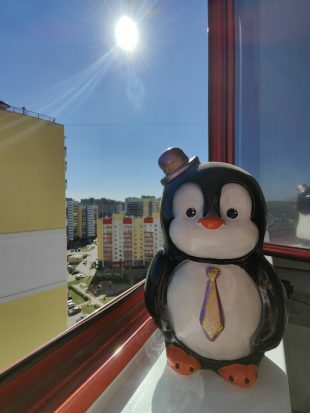
5 / 0
Shot with a wide-angle camera. Photo: Victor Podvolotsky / Lifehacker
The second module of the smartphone is 13 MP wide-angle. It shoots well in general, without geometry distortion, but with a loss of detail along the edge of the frame. With a lack of light, this will be critical.
The third sensor is a 12MP telephoto lens for 5x optical zoom. It is complemented by excellent stabilization (OIS) and allows you to take very decent shots of distant objects.

1 / 0
Frame ×1. Photo: Victor Podvolotsky / Lifehacker

2 / 0
Frame ×5. Photo: Victor Podvolotsky / Lifehacker
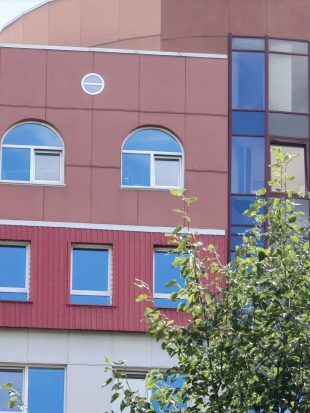
3 / 0
Frame ×10. Photo: Victor Podvolotsky / Lifehacker
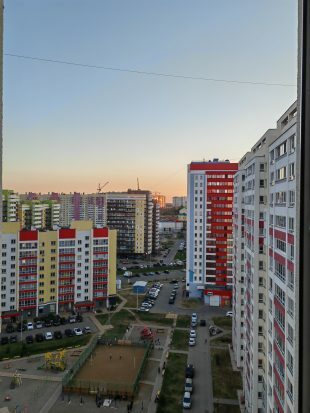
4 / 0
Frame ×1. Photo: Victor Podvolotsky / Lifehacker
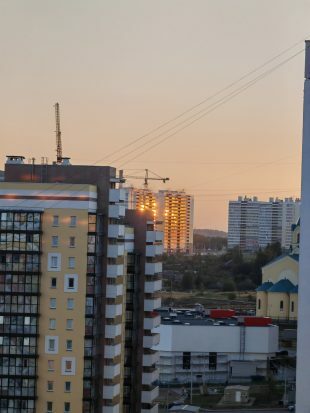
5 / 0
Frame ×5. Photo: Victor Podvolotsky / Lifehacker

6 / 0
Frame ×10. Photo: Victor Podvolotsky / Lifehacker

7 / 0
Frame ×1. Photo: Victor Podvolotsky / Lifehacker

8 / 0
Frame ×5. Photo: Victor Podvolotsky / Lifehacker

9 / 0
Frame ×10. Photo: Victor Podvolotsky / Lifehacker
However, due to the low resolution, it is better not to use a zoom of more than 10x. In this regard, the P50 is inferior to the Pro version with a 64-megapixel sensor, from which good crops were obtained. For the same reason, the P50 will not be able to take a cool photo. Moon, when even craters are visible (the P50 Pro did an excellent job of this).

1 / 0
Photo: Victor Podvolotsky / Lifehacker

2 / 0
Photo: Victor Podvolotsky / Lifehacker
The front camera is technically quite ordinary, at 13 megapixels, with a fixed focus. I didn’t have high hopes for her, but she still surprised me with a pleasant processing of portraits. Retouching algorithms carefully remove strong skin imperfections while maintaining its natural tone, although you can choose any you want - lighter, more pink, tan, and so on.
Autonomy and charging
In terms of battery life, the smartphone is the most average - about 5 hours of active screen per day. It's right next to morning and until the evening.
For the owner of a 4,100 mAh battery, the figure is quite expected, especially considering the screen with a frequency of 90 Hz. If you lower it to 60 Hz and, for example, do not turn on Always on Display, you can get an additional half hour to an hour of work.
Given the 66W charge, with which the smartphone fully restores energy in about 50 minutes, a small autonomy is not a serious problem. But the lack of wireless recharge for someone can be critical.
Results
Apart from the problems with Google services, to which many network activities have long been tied, the Huawei P50 is an excellent smartphone. Even with a not the newest chip, it could well compete with the same Galaxy S22, offering excellent ergonomics and wide shooting capabilities.
This smartphone looks like a flagship and feels like a full-fledged flagship, and not a “stripped down” model for the sake of a slightly lower price tag. Therefore, if you missed Google a long time ago, you are in no way tied to gmail and use, for example, only Yandex services, Huawei P50 is definitely worth considering for purchase.
Advantages
- Good ergonomics.
- Flat screen with narrow bezels.
- Great main camera.
- Good 5x zoom.
- Fast charging.
Flaws
- Mark Corps.
- Absence Google services.
- Outdated processor.
- heating under load.
Now Huawei P50 costs about 50,000 rubles. And this is a very interesting offer in the face of rising prices for many similar models.
Read also🧐
- Huawei MateBook D16 review - updated model with Core i7 and 16: 10 screen
- Huawei Sound Joy wireless speaker review - a worthy competitor to JBL Flip
- Review of the smartphone Poco F3 - the same "top for your money"


